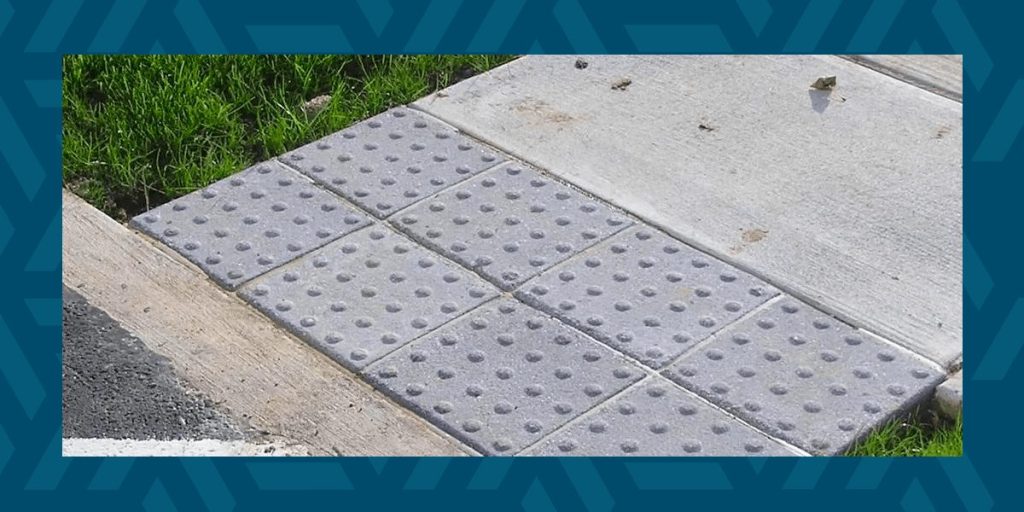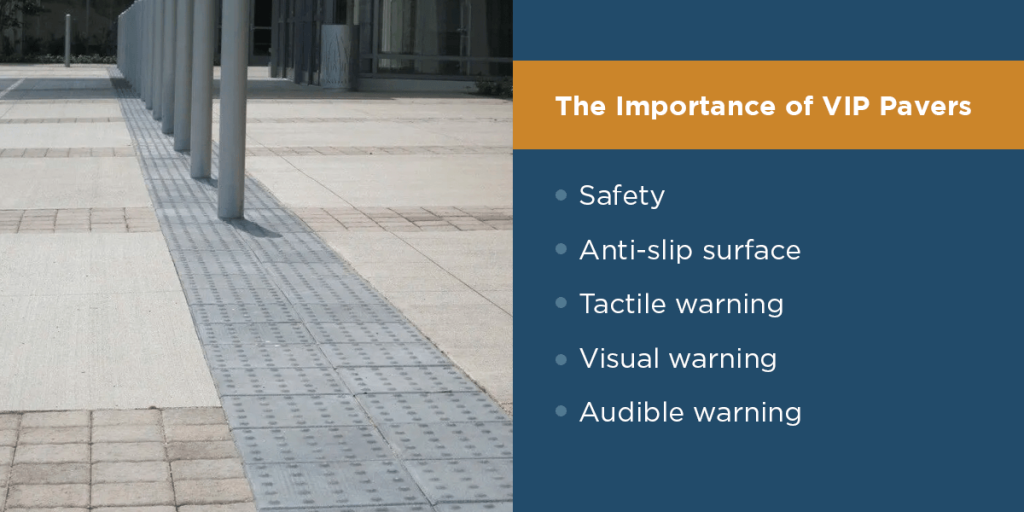
In America, there are over 7 million people with vision loss or blindness who need aid to go about their everyday lives comfortably and safely. Through design, there are multiple ways we can support those with visual impairment and improve the safety of cities and spaces. One simple method is to incorporate a combination of detectable warning systems, including visually impaired pedestrian (VIP) pavers. When implemented correctly in the right locations, these colorful, textured pavers alert people with vision loss to unsafe areas such as crosswalks and train platforms.
This guide covers everything you need to know about VIP pavers, their importance in public spaces and how they’re regulated in America. More importantly, you’ll discover where to add them to create safe, accessible spaces for all.
What Are VIP Pavers?
VIP pavers — also known as tactile pavers, detectable warning surfaces or truncated dome tiles — are textured pavers that help people with visual impairments navigate outdoor environments. They do this through raised bumps on the paver’s surface that people can see, feel and hear.
The Americans with Disabilities Act (ADA) regulates VIP pavers in public spaces throughout the U.S. This act promotes accessible and safe public spaces for people of all abilities and prohibits discrimination based on disability. To achieve this goal, the ADA created a set of standards and guidelines that specify the dimensions for detectable warning surfaces and their location in public spaces, including the ADA Accessibility Standards and the Public Right-of-Way Accessibility Guidelines.
The Importance of VIP Pavers
VIP pavers help people with visual impairments access and use public spaces confidently and independently. This is essential to creating inviting and enjoyable spaces for all community members.

Some more benefits of tactile pavers include:
- Safety: VIP pavers alert pedestrians to unsafe areas and tripping hazards, creating a safer environment.
- Anti-slip surface: The domes on VIP pavers and their textured finish create a slip-resistant surface, minimizing fall risk and injury.
- Tactile warning: VIP pavers provide a change in ground texture, which acts as a tactile warning cue for people with partial or full blindness. People can feel these pavers when they walk over them, roll over them in a wheelchair or tap them with a cane.
- Visual warning: Along with a change in surface texture, VIP pavers come in bright colors that contrast with surrounding areas. This creates a visual warning for people with sight or partial blindness, allowing them to make safe choices while walking.
- Audible warning: When a person taps VIP pavers with their guidance cane, the domes create a different sound than the surrounding surfaces. This audibly alerts people before they reach a potentially unsafe area.
VIP Paver Applications
You can install VIP pavers in any area you want to make safer and more accessible for people with visual impairments, including in commercial buildings and residential properties. However, the ADA has standards that outline when to use VIP pavers, and you must follow these standards to remain compliant and ensure the pavers work as intended.
The ADA standards apply to any space open to the public, including government facilities, commercial buildings or transit areas. If your property falls into one of these categories, you must install VIP pavers in specific locations as outlined in the ADA to warn people about potential safety issues. However, you can use VIP pavers anywhere you feel will benefit people with disabilities.
Here are the most common applications of VIP pavers.
1. Pedestrian Crossings
One of the most common places for VIP pavers is at pedestrian crossings. Crossing a road is unsafe for people with limited vision, so installing detectable warning surfaces on both sides of the crossing will alert people when they’re about to enter traffic. The VIP pavers indicate where it’s safe to stand, and combined with a sound and light cue, they help people safely cross the road.
This same principle applies to walkways over train tracks and pedestrian islands in the middle of the road too. You must place the pavers at a sufficient distance from the crossing to warn people before they reach it.
2. Curb Ramps
A curb ramp is a gentle slope from a sidewalk to a roadway — such as by a pedestrian crossing — that creates a safer transition for people with limited vision, wheelchair or walker users, and even people riding bikes or pushing strollers. To make these transitions easier to find and warn people about the change in height, you’ll need to place VIP paving along the full width of the curb ramp.
3. Drop-Offs and Transit Platforms
The ADA requires detectable warning tiles along areas with a drop-off and no railings, guards or protective screens. This includes transit areas like train platforms and plane boarding areas where a person with low vision could easily fall without clear warning. You should place VIP pavers along the full width of the platform or drop-off to warn people they’re about to reach the edge.
4. Elevation Changes
Whenever there is a change in height along a walkway — such as with stairs, escalators and wheelchair ramps — you should place VIP pavers at the bottom and top to alert people to the change and prevent falling or tripping.
5. Pools
Swimming pools and other bodies of water are also dangerous if you have a vision impairment. Prevent people from falling into them by placing VIP pavers around the pool or water feature with some space to provide adequate warning.
VIP Paver Colors
People with partial blindness can often see bright, contrasting colors and textures, which is why VIP pavers typically come in red or yellow. These colors stand out against the grey concrete to provide a visual warning of an unsafe area. According to ADA regulations, VIP pavers must have a minimum of 70% color contrast to work effectively. You can use other colors for your VIP pavers as long as they meet this requirement.
Purchase Compliant VIP Pavers From Nitterhouse Masonry
Whether you need to design accessible buildings or make it easier for a loved one to get to your home, you’ll want high-quality VIP pavers that meet ADA standards. Since 1923, Nitterhouse Masonry has been manufacturing a wide range of quality concrete products, including VIP pavers. Our pavers meet all ASTM 936 specifications and comply with the ADA. They also come in various colors and finishes to look attractive while offering safety benefits.
https://www.nitterhousemasonry.com/our-products/vip-pavers/Browse our VIP pavers options and other pavers and paving stones online today. If you need any assistance choosing the proper size or color for your application, don’t hesitate to call us at 717-267-4500 or fill out our online contact form.



